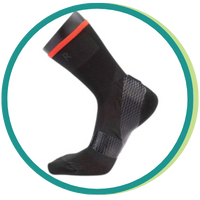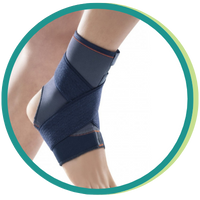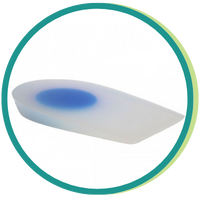
Pronation: What It Is and How to Choose the Right Footwear
What Is Pronation?
Pronation is the natural movement of the foot when it touches the ground during walking or running. This movement occurs when the ankle slightly rolls inward to absorb impact and distribute body weight. Pronation is essential for balanced and efficient walking, but when it happens excessively or insufficiently, it can cause pain and injuries.
The way feet interact with the ground directly influences body stability, impact absorption, and even posture alignment. Having a balanced pronation pattern helps reduce muscle fatigue and lowers the risk of long-term orthopedic problems. Additionally, improper pronation can cause discomfort that affects not only the feet but also the knees, hips, and spine. That’s why understanding your gait pattern is crucial when choosing the right footwear.
Knowing your pronation type is key to selecting the appropriate footwear and preventing issues such as plantar fasciitis, knee pain, and postural imbalances. A preventive approach with the right footwear and accessories can make a significant difference in your quality of life and physical performance.
Pronation vs. Supination: Differences and Their Impact on Foot Health
Pronation and supination are opposite movements that affect how the foot absorbs impact and moves. While pronation involves the inward rotation of the ankle and foot arch, supination happens when body weight is placed on the outer part of the foot. Both movements are natural and part of the body’s biomechanics, but when excessive, they can cause discomfort and increase the risk of injuries.
Excessive pronation can overload muscles and joints, leading to issues like plantar fasciitis and tendonitis. On the other hand, excessive supination results in reduced impact absorption, putting extra stress on the ankle, knee, and even spinal joints. That’s why it is essential to identify your foot type to choose the right footwear and avoid long-term complications.
Painful Pronation: When to Seek Help?
Painful pronation is a common issue in people whose feet are misaligned when walking or running. When pronation is inadequate, it can cause persistent pain in the sole of the foot, ankles, and even the lower back. This discomfort may be linked to chronic inflammations such as tendonitis and plantar fasciitis, which can affect mobility and daily well-being.
If you experience frequent pain while walking or exercising, it is essential to consult a healthcare professional to determine the cause. Wearing proper footwear, using orthopedic insoles, and performing strengthening exercises can help correct painful pronation, providing greater stability and comfort.
Pronation and Performance: How It Affects You
Foot pronation directly influences how the body distributes weight during movement. Athletes and fitness enthusiasts should be aware of their pronation type, as misalignment can impact performance and increase the risk of injuries. The repetitive impact associated with improper pronation can affect running, cycling, and other sports.
Wearing sports shoes suited to your pronation type enhances performance, reduces muscle fatigue, and provides a more comfortable experience during physical activities. Additionally, accessories like compression socks and specialized insoles can correct minor misalignments and offer extra support.
How to Know if You Are a Pronator or a Supinator?
There are a few simple tests you can do at home to determine your pronation type, allowing you to adjust your footwear and avoid unnecessary discomfort.
1. Wet Footprint Test
Wet your feet and step onto a piece of paper or a dry surface where you can see the imprint.
- If the footprint shows almost the entire sole of your foot, you likely have overpronation.
- If the mark only shows the heel and the tips of your toes, it may indicate supination.
This test is a simple and practical way to assess the shape of your foot arch and predict potential pronation tendencies.
2. Shoe Wear Test
Examine the soles of your worn-out shoes:
- Even wear: Neutral pronation.
- More wear on the inner side: Overpronation.
- More wear on the outer side: Supination.
This test is useful for those who have been using the same type of shoes for some time. The wear pattern can indicate how your foot distributes weight while walking, helping to identify improper pronation patterns.
3. Professional Evaluation
A podiatrist or biomechanics specialist can perform more precise tests, such as gait analysis on a treadmill and plantar pressure assessments, to determine your pronation type. Professionals can recommend footwear adjustments, custom insoles, and even exercises to strengthen foot and ankle muscles.
The Importance of Pronation in Running
For runners, knowing their pronation type is essential when choosing the right running shoes. Proper footwear can enhance performance and prevent injuries such as tendonitis, knee pain, and stress fractures.
Pronation directly affects running biomechanics, impacting shock absorption and force distribution. Choosing footwear that provides adequate support for your pronation type can help prevent premature fatigue, improve stride efficiency, and reduce the risk of muscle injuries.
Choosing Footwear for Each Pronation Type
- Neutral Pronation: Shoes with balanced cushioning and moderate support.
- Overpronation: Shoes with extra stability and motion control support.
- Supination: Shoes with increased cushioning and flexibility for better shock absorption.
Besides choosing the right footwear, runners can benefit from orthopedic accessories that help correct minor misalignments, providing greater comfort and safety while running.
Recommended Products for Support and Comfort
If you are looking for solutions to improve stability and correct improper pronation, consider:

Power Socks Sport Competition Pronation Control Sock
Help maintain foot stability and prevent excessive movement.

Neoprene Foot Support with Cross Band
Ideal for providing additional arch support and reducing pain.
Conclusion
Choosing the right footwear and using appropriate accessories can significantly improve your quality of life and athletic performance. For more options, visit Loja Ortopédica.





No Comments